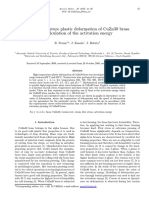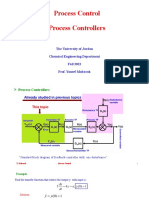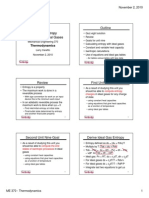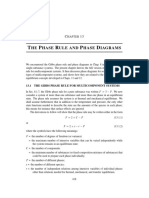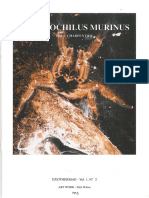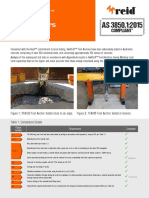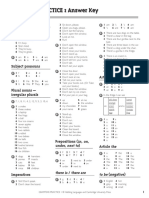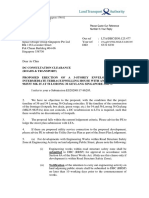C4 Heat Effects
C4 Heat Effects
Uploaded by
Jack HoCopyright:
Available Formats
C4 Heat Effects
C4 Heat Effects
Uploaded by
Jack HoCopyright
Available Formats
Share this document
Did you find this document useful?
Is this content inappropriate?
Copyright:
Available Formats
C4 Heat Effects
C4 Heat Effects
Uploaded by
Jack HoCopyright:
Available Formats
Source: Equations and examples adopted from Smith, J.M., Van Ness, H.C. and Abbott, M.M.
Introduction to Chemical Engineering Thermodynamics, 7th Edition, McGraw-Hill, 2005(if not specified elsewhere)
Chapter 4: Heat Effects
Heat transfer is common in chemical industry. Combustion, extraction, distillation etc. involve heat effects that accompany physical and chemical changes with the principle of thermodynamics.
Objective
To apply thermodynamics to the evaluation of the heat effects that accompany physical and chemical operations
Sensible heat effects (temperature change) Latent heat effects (phase transition) Heat effects of chemical reaction, formation, and combustion under standard conditions as well as actual industrial conditions Heat effects of mixing processes (not treated in this chapter)
Sensible Heat Effects
Relations between quantity of heat transferred and resulting temperature change
For mechanically reversible, constant-volume, closed-system processes
Q = U = CV dT
T1
T2
For mechanically reversible, constant-pressure, closed-system processes / steady-flow heat transfer where EP , EK 0, Ws = 0
Q = H = C P dT
T1
T2
Sensible heat effects are characterised by temperature changes in a system in which there are no phase transitions, no chemical reactions, and no changes in composition.
3
Heat Capacity:Temperature Dependence
ig
CP 2 2 = A + BT + CT + DT R
ig Ideal-gas heat capacity, C P rather than actual heat capacity
More convenient for thermodynamic-property evaluation in two steps:
1.
2.
Calculation for hypothetical ideal-gas-state values Correction to real-gas values
Parameters in equation for CP can be found in App. C.
Relations between the two ideal-gas heat capacities
ig ig CV CP = 1 R R
Heat Capacity: Gas Mixtures
ig ig ig ig C Pmix = y A C PA + y B C PB + y C C PC + ...
ig C Pmix =
ig y i C Pi
In an ideal-gas mixture, the molecules have no influence on one another, and each gas exists independent of the others.
6
Heat Capacity: Evaluation of the Integral
T T ig P
C Q = H = C P dT = R dT T0 T0 R
To calculate Q or H given T0 and T:
Read textbook, Smith et al. (2005) p.130 and Ex. 4.2 for details.
Heat Capacity: Evaluation of the Integral
To calculate T given T0 and Q or H (an iteration scheme is helpful):
1. Guess T, then calculate , then substitute into Eq. (4.8)
H
H = C P
(T T0 )
2. Substitute <CP>H into Eq. (4.10) to get new T
H T= + T0 CP H
(4.10)
3. Substitute new T into Eq. (4.8) to reevaluate <CP>H until iteration converges.
8
Read textbook, Smith et al. (2005) p.130 for details.
Exercise: Problem 4.2 (a)
For steady flow through a heat exchanger at approximately atmospheric pressure, what is the final temperature, (a) when heat in the amount of 800 kJ is added to 10 mol of ethylene initially at 200C (473.15 K)?
103 B = 14.394 B = 14.394 x 10-3
10
Exercise: Problem 4.2 (a) (contd)
Guess T = 400C (673.15 K), thus = 2.
CP
R CP
14.394 10 3 4.392 10 6 (473.15)(2 + 1) + (473.15)2 22 + 2 + 1 + 0 = 1.424 + 2 3
= 9.346
H T= + T0 CP H
11
Latent Heats of Pure Substances
Phase transition, coexistence of two phases, no temperature change Clapeyron equation (derived in Chapter 6)
dP sat H = TV dT
Troutons rule (rough estimates at Tn) H n 10 RTn
12
Latent Heats of Pure Substances
H n 1.092(ln Pc 1.013) = RTn 0.930 Trn
P (bar)
Riedel equation (high accuracy, error < 5%)
Watson equation (with a known value, experimental or estimated by Riedel equation)
H 2 1 Tr2 = H1 1 Tr1
0.38
13
Standard Heats: Reaction, Formation, Combustion
Revision: Read Chapter 4 (4.3-4.5), Smith et al. (2005)
H o vi H o fi
i
Positive (+) for products Negative () for reactants
Standard states: pure substance at ideal-gas state at 1 bar, real pure liquid or solid at 14bar 1
15
Standard Heats:Temperature Dependence
temperature change
temperature change
chemical reaction
16
Standard Heats:Temperature Dependence
17
Standard Heats:Temperature Dependence
18
Example 4.6: Standard heat at temperature other than 298.15 K
Calculate standard heat of methanol-synthesis reaction at 800C (1073.15 K):
CO(g) + 2H2(g)
CH3OH(g)
19
Ai = A
20
21
Heat Effects of Industrial Reactions
Industrial reactions are often carried out under/with
non standard-state conditions non stoichiometric proportions reaction not go to completion variation in temperature presence of inert several reactions simultaneously
22
23
24
Conclusions
In this chapter, we have evaluated the heat effects that accompany physical and chemical operations from the point of thermodynamics. We have examined
Sensible heat effects (as a result of temperature change) Latent heat effects (due to phase transition) Heat effects of chemical reaction, formation, and combustion under
standard conditions actual industrial conditions
Self study
25
Read Chapter 4 (Smith et al. 2005) Attempt Tutorial 3: Problems 4.11, 4.38, 4.49,4.51
You might also like
- Smith - 8th CH 12 Phase Equilibrium IntroductionDocument14 pagesSmith - 8th CH 12 Phase Equilibrium Introductionjeongyun271No ratings yet
- QC's SOPDocument11 pagesQC's SOPDavid See100% (1)
- CHAPTER 03 - 2nd Part - Properties of Pure Fluids-May20Document49 pagesCHAPTER 03 - 2nd Part - Properties of Pure Fluids-May20Scorpion Royal100% (1)
- Diagrama Hidraulico Caterpillar 345cDocument2 pagesDiagrama Hidraulico Caterpillar 345cJose Miguel Gary Vargas100% (1)
- Chapter 4 Heat EffectsDocument6 pagesChapter 4 Heat Effectsariana religiosoNo ratings yet
- Chapter 4Document64 pagesChapter 4Biru EsheteNo ratings yet
- MODULE 3 - 2nd and 3rd LAW OF THERMODocument16 pagesMODULE 3 - 2nd and 3rd LAW OF THERMOimPERFECTme09No ratings yet
- Chapter 7 Chemical EquilibriumDocument35 pagesChapter 7 Chemical EquilibriumgajenraoNo ratings yet
- Generalized Correlations For GasesDocument3 pagesGeneralized Correlations For GasesAllen Dimayuga100% (1)
- 0 B264 D 01Document18 pages0 B264 D 01didikkrisNo ratings yet
- Chapter 3 Volumetric Properties of Pure Fluids PDFDocument8 pagesChapter 3 Volumetric Properties of Pure Fluids PDFNikko ManaleseNo ratings yet
- Thermochemistry NotesDocument5 pagesThermochemistry NotesNephtali Pinos-an100% (1)
- Solution Thermodynamics: Theory: Fundamental Property RelationDocument6 pagesSolution Thermodynamics: Theory: Fundamental Property RelationLim Ying PeiNo ratings yet
- The First Law and Other Basic Concepts PDFDocument64 pagesThe First Law and Other Basic Concepts PDFeyezakeyeNo ratings yet
- CET 2 - Chemical Reaction EquilibriumDocument46 pagesCET 2 - Chemical Reaction EquilibriumMihir ParekhNo ratings yet
- Thermo Chemical Reaction EquilibriaDocument41 pagesThermo Chemical Reaction EquilibriaDede SyahputraNo ratings yet
- Stage & Continuous Gas-Liquid Separation Processes: Chapter ThreeDocument116 pagesStage & Continuous Gas-Liquid Separation Processes: Chapter ThreeDoni RopawandiNo ratings yet
- 12 Energy and Energy BalancesDocument55 pages12 Energy and Energy BalancesShams Uzzoha75% (8)
- Chapter 7 PDFDocument94 pagesChapter 7 PDF김민성No ratings yet
- 2-CHAPTER 2-First Law of Thermodynamics-Closed SystemDocument42 pages2-CHAPTER 2-First Law of Thermodynamics-Closed System许凉发100% (1)
- 2.3 Stability of Feedback Control SystemsDocument30 pages2.3 Stability of Feedback Control SystemsJust RobotNo ratings yet
- Chapter 4 - Radiation Heat Transfer PDFDocument52 pagesChapter 4 - Radiation Heat Transfer PDFSuraya Johari0% (1)
- Two ComponentsDocument19 pagesTwo ComponentsMumtaz AhmadNo ratings yet
- Physical ChemistryDocument12 pagesPhysical ChemistryBethel Joy S. TapallaNo ratings yet
- Thermodynamic Property RelationsDocument26 pagesThermodynamic Property RelationsSec CNo ratings yet
- Cap 12 TermoDocument10 pagesCap 12 TermoYaileen MoralesNo ratings yet
- Atkins' Physical Chemistry: Chapter 2 - Lecture 4Document15 pagesAtkins' Physical Chemistry: Chapter 2 - Lecture 4Budi AbutNo ratings yet
- L2.PC - tmr.FALL23 (TheoreticalModels CH2)Document43 pagesL2.PC - tmr.FALL23 (TheoreticalModels CH2)zubairnaeem 92No ratings yet
- Phychem Chapter 3 Part 1Document14 pagesPhychem Chapter 3 Part 1Skye DiazNo ratings yet
- 3 - Vle in A Binary Mixture - 2Document22 pages3 - Vle in A Binary Mixture - 2Faisal El HakimNo ratings yet
- High Temperature Plastic Deformation of CuZn30 BraDocument6 pagesHigh Temperature Plastic Deformation of CuZn30 Bramahan nikNo ratings yet
- Process Control - Chapter 7JUDocument42 pagesProcess Control - Chapter 7JUY MuNo ratings yet
- 7 1. Vapor Liquid EquilibriumDocument9 pages7 1. Vapor Liquid Equilibriumwaseemkhan49No ratings yet
- 14 EquilibriumDocument6 pages14 EquilibriumAgam HanasichulaNo ratings yet
- Solution ThermoDocument29 pagesSolution ThermoNur AqilahNo ratings yet
- Ideal Gas EntropyDocument6 pagesIdeal Gas EntropyAlan A. AlexanderNo ratings yet
- L20 - Entropy Balance EquationDocument18 pagesL20 - Entropy Balance EquationcacacocoNo ratings yet
- Phase EquilibriaDocument31 pagesPhase EquilibriaLogesh SelvamaniNo ratings yet
- Vapor-Liquid Equilibrium (Vle) - PortalDocument39 pagesVapor-Liquid Equilibrium (Vle) - PortalKaizerNo ratings yet
- The First Law: Atkins / PaulaDocument65 pagesThe First Law: Atkins / Paula蔡承德No ratings yet
- Biofuels Algae CaseStudy 09Document30 pagesBiofuels Algae CaseStudy 09Aaron AppletonNo ratings yet
- FugsDocument60 pagesFugsFaisal MumtazNo ratings yet
- CHAPTER 6-Second Law of ThermodynamicsDocument29 pagesCHAPTER 6-Second Law of ThermodynamicsAbuzar AliNo ratings yet
- 4 Chemical EquilibriumDocument94 pages4 Chemical EquilibriumJoseph Bien Mercado OdiñaNo ratings yet
- Electrochemical EquilibriumDocument13 pagesElectrochemical EquilibriumChelsea MartinezNo ratings yet
- Section 4.1Document30 pagesSection 4.1Tang Sim YingNo ratings yet
- Chapter 2 Heat EffectsDocument27 pagesChapter 2 Heat Effectsprakash_krishnan_2No ratings yet
- Advanced Thermodynamics: Vapor/Liquid EquilibriumDocument28 pagesAdvanced Thermodynamics: Vapor/Liquid Equilibriumdo_overNo ratings yet
- Lecture Five Energy BalancesDocument51 pagesLecture Five Energy BalancesHebron DawitNo ratings yet
- Chapter 6: Solution Thermodynamics and Principles of Phase EquilibriaDocument51 pagesChapter 6: Solution Thermodynamics and Principles of Phase EquilibriaayushNo ratings yet
- CBB 2024 Chapter 4-Second Law of Thermo V2Document90 pagesCBB 2024 Chapter 4-Second Law of Thermo V2Ameer Muhammad100% (1)
- 08 Fugacity of Species in A Solution PDFDocument41 pages08 Fugacity of Species in A Solution PDFJovi LeoNo ratings yet
- Mass Transfer - Ii (KCH 601) Unit - 2: Vinay Mishra Deptt of Chemical Engineering IET LucknowDocument10 pagesMass Transfer - Ii (KCH 601) Unit - 2: Vinay Mishra Deptt of Chemical Engineering IET LucknowkrishnaNo ratings yet
- Saperation 1: Ass. Prof. Adnan Ripin Faculty of Chemical and Energy Engineering Universiti Teknologi MalaysiaDocument79 pagesSaperation 1: Ass. Prof. Adnan Ripin Faculty of Chemical and Energy Engineering Universiti Teknologi MalaysiaNurul AinNo ratings yet
- The Phase Rule and Phase Diagrams-T and CDocument31 pagesThe Phase Rule and Phase Diagrams-T and CKunwarPawanSinghBhatiNo ratings yet
- 181CTDCHA2 - Learning Unit 1BDocument64 pages181CTDCHA2 - Learning Unit 1BESTHER TSAKANE MONKWENo ratings yet
- Energy Balances On Non-Reactive Processes PDFDocument36 pagesEnergy Balances On Non-Reactive Processes PDFMohammed Almorisey100% (1)
- Introductory Chemistry B CH4751 Lecture Notes 11-20: Dr. Erzeng XueDocument81 pagesIntroductory Chemistry B CH4751 Lecture Notes 11-20: Dr. Erzeng XuethanhndbNo ratings yet
- Chapter 8Document36 pagesChapter 8Shannon NortjeNo ratings yet
- A Modern Course in Statistical PhysicsFrom EverandA Modern Course in Statistical PhysicsRating: 3.5 out of 5 stars3.5/5 (2)
- “Foundations to Flight: Mastering Physics from Curiosity to Confidence: Cipher 4”: “Foundations to Flight: Mastering Physics from Curiosity to Confidence, #4From Everand“Foundations to Flight: Mastering Physics from Curiosity to Confidence: Cipher 4”: “Foundations to Flight: Mastering Physics from Curiosity to Confidence, #4Rating: 5 out of 5 stars5/5 (1)
- OperationalDescription - ST500 - SB - REV1.2 - 20161201.F.H.DE SOUZA - RASTREADORES - ME - Marked PDFDocument75 pagesOperationalDescription - ST500 - SB - REV1.2 - 20161201.F.H.DE SOUZA - RASTREADORES - ME - Marked PDFrichardNo ratings yet
- 10 Mechanical Equipment, Attachment PDFDocument8 pages10 Mechanical Equipment, Attachment PDFPeter BrickNo ratings yet
- 7470 Charpentier 1993 Exo 1 1 72Document73 pages7470 Charpentier 1993 Exo 1 1 72Ferenc TörökNo ratings yet
- Omniaccess Stellar Ble Beacons Datasheet enDocument3 pagesOmniaccess Stellar Ble Beacons Datasheet enAsnake TegenawNo ratings yet
- Drop SocioEconomic ImpactDocument7 pagesDrop SocioEconomic ImpactChan ZyNo ratings yet
- Reid™ SwiftLift™ Foot Anchors AS3850-2015 ComplianceDocument4 pagesReid™ SwiftLift™ Foot Anchors AS3850-2015 ComplianceAdamMitchellNo ratings yet
- South Ghawar Project Inspection Unit (SGPIU) Test For QC Inspector (Earthwork/Paving)Document4 pagesSouth Ghawar Project Inspection Unit (SGPIU) Test For QC Inspector (Earthwork/Paving)Khurram ShehzadNo ratings yet
- Chrysler JX Stratus Sebring Convertible LHD RHD 1997 Service Manual Ignition SystemDocument28 pagesChrysler JX Stratus Sebring Convertible LHD RHD 1997 Service Manual Ignition SystemjjrmgNo ratings yet
- Physical Pharmacy Lab - Post LabsDocument90 pagesPhysical Pharmacy Lab - Post LabsFlorence Lynn BaisacNo ratings yet
- Stilan Non Slip Brochure 2016Document2 pagesStilan Non Slip Brochure 2016Arrow BuildersNo ratings yet
- White Paper 134Document21 pagesWhite Paper 134Flo MircaNo ratings yet
- Usa Amc - 12 Ahsme 2013Document10 pagesUsa Amc - 12 Ahsme 2013Wang WilliamNo ratings yet
- Abit AX78 Motherboard ManualDocument80 pagesAbit AX78 Motherboard ManualDuckyLuckyNo ratings yet
- Cement Milling and Separator Closed CircuitDocument35 pagesCement Milling and Separator Closed CircuitmohamedredaNo ratings yet
- Infinair Fan Data SheetDocument2 pagesInfinair Fan Data SheetInsertec LtdaNo ratings yet
- Đề 1.the Answers Key - Tiếng Anh 8 I-Learn Smart World - Kiểm Tra Giữa Kỳ 2Document2 pagesĐề 1.the Answers Key - Tiếng Anh 8 I-Learn Smart World - Kiểm Tra Giữa Kỳ 2Tiếng Anh 7No ratings yet
- A ReviewDocument17 pagesA ReviewkanomasiNo ratings yet
- Lecture 1,2,3 - Early Christian & Byzantine ArchitectureDocument50 pagesLecture 1,2,3 - Early Christian & Byzantine ArchitectureYadhu .msa17No ratings yet
- Hydro Test Pressure For PipesDocument3 pagesHydro Test Pressure For Pipesmilan rabadiyaNo ratings yet
- APN Solar Energy - 14K PDFDocument1 pageAPN Solar Energy - 14K PDFRajeev KumarNo ratings yet
- Grammar Practice Level1 Answer KeyDocument7 pagesGrammar Practice Level1 Answer KeyWisrut MueangkaeoNo ratings yet
- Datsun Blue Bird Parts Catalog 410 411 1964 68Document20 pagesDatsun Blue Bird Parts Catalog 410 411 1964 68andrea100% (62)
- Bca SyllabusDocument55 pagesBca Syllabusapi-349492533No ratings yet
- Lec 9 OT Problem FormulationDocument50 pagesLec 9 OT Problem FormulationMuhammad Bilal Junaid100% (1)
- Appendix 1 URS For Isolator and Safety Cabinets PDFDocument31 pagesAppendix 1 URS For Isolator and Safety Cabinets PDFRND BiotisNo ratings yet
- 2020年杜卡迪Hypermotard 950 -用户手册 PDFDocument302 pages2020年杜卡迪Hypermotard 950 -用户手册 PDF张连杉No ratings yet
- 251 North Bridge Road Singapore 179102 Visit Us at "WWW - Lta.gov - SG"Document2 pages251 North Bridge Road Singapore 179102 Visit Us at "WWW - Lta.gov - SG"YADI JAYADINo ratings yet
- Science: Organic Compounds and Functional GroupsDocument38 pagesScience: Organic Compounds and Functional GroupsEunice AnogNo ratings yet






























